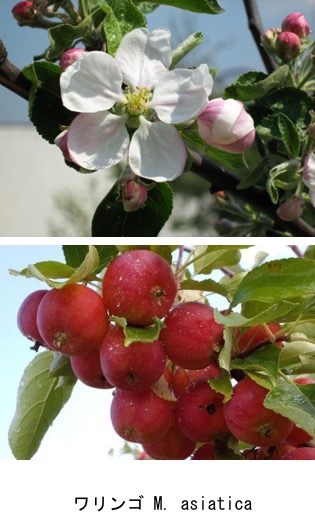リンゴは最も親しまれている果物の一つ.
その歴史についても,様々なことが分かってきているようです.

現在のりんごの歴史については,青森県の「りんご果樹課」(さすが青森.りんごが課として独立している)の解説が良くまとまっているようの思われました.
ほぼそのまま引用に,内容のいくつかについて,註の形で,他のサイトの情報を補足させて頂きます.
リンゴ栽培の歴史と原種
(原種 https://www.pref.aomori.lg.jp/sangyo/agri/ringo-rekisi01.html より)
日本の文献では,8から12世紀に林檎(リウコウ)と奈(ナイ)という2種のりんごがみられることから,かなり以前かに揚子江流域の原種が渡ってきたものと推測されています.最初のりんごは,小さくて食味の悪いものだったらしいのですが,12世紀には菓子として林檎の文字が文献に見られることから,少しずつ普及したのかもしれません(*1).
日本のりんご産業は,明治時代の文明開化とともに日本に来たアメリカ系の西洋りんごとともに始まりました.ヨーロッパ系も入ってきましたが,ヨーロッパ系は乾燥地域のりんごが多く,一方,アメリカ系は比較的降水量の多い東部地域から入ってきたため,雨の多い日本には,アメリカ系が定着しました(*2).
日本では,りんごの導入以来,外国産品種が主流となっていましたが,昭和初期から育種研究が進められ,昭和30年代からようやく日本独自の品種が栽培されるようになりました.
りんごの発祥地については,諸説あります.
アメリカ系りんごの元となったのは,ヨーロッパ系です.では,ヨーロッパ系のりんごはどこから来たのでしょうか.
りんごの原種はいくつかの地域に分布していますが,私たちが現在食べているりんごの原種は,コーカサス地方から北部ペルシャ(イラン)地方,中央アジアの天山山脈(トルキスタンから新疆)に自生しているものが原種と考えられています(*3).
最近はこれらに加えて,ピレネー山脈一帯のヨーロッパに自生している種の三種が交雑して現在のりんごとなったという説もあります(*4).

https://www.pref.aomori.lg.jp/sangyo/agri/ringo-rekisi01.html
*1 “和りんご”に関しては,やや異なった記述がウェブ上に見つかります. http://www.ringomuseum.com/history/nihonnoringo.html

http://www.ringomuseum.com/history/nihonnoringo.html
日本に渡来したのは,平安時代中期(900年頃)とされています. 当時は「和リンゴ」という粒の小さな野生種…いわゆる「観賞用」のりんごでした.
「和リンゴ」は「林檎」という漢字とともに日本へやってきました.当時は「利牟古(りむご)」と呼ばれ,「りんご」という和名が付けられたのは江戸時代です.小振りで酸味が強く,江戸時代にはお菓子として食べられていたとか.
ところが,「西洋リンゴ」の本格的栽培と数々の品種改良が進むにつれ,「りんご」という名前は「西洋リンゴ」を意味するようになりました.
*2 りんごの初栽培異説
初期のりんご栽培は,政府主導で行われたようですが,苗木の購入以外に,各国の農業技術者が招かれ,その技術を学ぶことで定着していったようです.
青森県のサイトでは触れられていませんが,北海道函館での苗木育成が日本初の栽培りんごという説がありました.どちらが主ということではなく,アメリカから輸入した苗木栽培は,北海道の技術も取り入れながら,青森で最も発展していったと考えれば良いように思われました.
▽官⇒青森 説
https://www.ringodaigaku.com/study/study07.html
|
1874年(明治7年) |
内務省勧業寮がりんごの苗木の全国配布 |
|
1875年(明治8年) |
|
|
1877年(明治10年) |
弘前市の山野茂樹が試植したりんごが初結実.後の山野早生(紅魁) |
▽ドイツ⇒北海道⇒青森説
http://www.ringomuseum.com/history/nihonnoringo.html
初栽培は青森…と思われがちですが,そうではありません.北海道函館市に隣接する小さな町,七重村(現:七飯町)が初栽培の地です.
明治元年にドイツ人の農業指導者R.ガルトネルが 「七重村農場」を開設,翌年(明治2年)には母国から取り寄せた苗木を植え付けた…これこそが日本における最初の栽培といえるでしょう.
その後,農場は明治新政府の手に引き継がれて「七重官園」となりました.
明治10年には「青森県りんごの始祖」とされる菊池楯衛(きくちたてえ)が来園,接木や苗木の仕立てといった技術を学んでいったそうです.
青森県ではそれらの技術が広まるとともに,栽培も盛んになりました.七重官園で習得した技術によって,リンゴ王国の基礎が作られた…といっても過言ではないでしょう.
*3 原種の学名はMalus sieversii
Malus sieversii

Malus sieversii PFAF Plant Database https://en.wikipedia.org/wiki/Malus_sieversii File:Malus sieversii 3.jpg - Wikimedia Commons
Malus sieversii is は,中央アジアカザフスタン原産の野生りんごです.栽培種のりんご(Malus pumila)の大部分の最初の原種であることが最近明らかにされました.
この種が初めに報告されたのは1833年,ドイツ人博物学者Carl Friedrich von Ledebourによるもので,アルタイ山脈で自生しているのを観察しています.
5〜12メートルになる落葉樹で,外観は栽培種ととてもよく似ています.その実は,pumila種(栽培種)を除くとりんご属の中で最も大きく,直径7センチメートルにもなり,近代の多くの栽培種と同じ大きさです.
Malus sieversii is a wild apple native to the mountains of Central Asia in southern Kazakhstan. It has recently been shown to be the primary ancestor of most cultivars of the domesticated apple (Malus pumila). It was first described (as Pyrus sieversii) in 1833 by Carl Friedrich von Ledebour, a German naturalist who saw them growing in the Altai Mountains.
It is a deciduous tree growing to 5 to 12 metres (16 to 39 ft), very similar in appearance to the domestic apple. Its fruit is the largest of any species of Malus except pumila, up to 7 cm diameter, equal in size to many modern apple cultivars.
*4 野生ヨーロッパリンゴの栽培種への関与
「栽培種りんごの歴史についての新たな知見.様々な栽培種品種のゲノム(全ての必要染色体1セット)へのヨーロッパ野生種の二次的関与 Amandine Cornille ら
PLOS GENETICS May 10, 2012 https://doi.org/10.1371/journal.pgen.1002703 」
要約
りんごは,温帯地域でもっとも広く見られ,文化的にも重要な栽培果物です.その起源と栽培化の歴史を明らかにすることは,とても興味深いことです.
中央アジア野生種のMalus sieversii が,栽培種(Malus domestica)ゲノムの主要な“貢献種”であることが,形態的,分子生物学的,そして歴史的なエビデンスをもとに,最近明らかにされました.
アジアから西洋へ向かうシルクロードに沿いの他の野生種,特にヨーロッパの野生種が寄与している可能性は,議論すべき事として残されています.
私たちは,ユーラシア(中国からスペインまでの839種収蔵??)から集めたりんご属5種のマイクロサテライトマーカー(ゲノム上に存在する反復配列)と前例のない広範囲のサンプリングを用いて,複数の種が栽培種のゲノム構成に貢献していることを確かめました.
野生のヨーロッパ“クラブアップル” M. sylvestris は,特に主な2次“貢献種”でした.栽培種と野生ヨーロッパ“クラブアップル”の双方向遺伝子流動のおかげで,現在の栽培種M. domesticaは,中央アジアの原種Malus sieversii より,この種(ヨーロッパ種M. sylvestris)に,より密接に関連することになりました(以下略)

New Insight into the History of Domesticated Apple: Secondary Contribution of the European Wild Apple to the Genome of Cultivated Varieties Amandine Cornille et .al
https://journals.plos.org/plosgenetics/article?id=10.1371/journal.pgen.1002703
Abstract
The apple is the most common and culturally important fruit crop of temperate areas. The elucidation of its origin and domestication history is therefore of great interest. The wild Central Asian species Malus sieversii has previously been identified as the main contributor to the genome of the cultivated apple (Malus domestica), on the basis of morphological, molecular, and historical evidence. The possible contribution of other wild species present along the Silk Route running from Asia to Western Europe remains a matter of debate, particularly with respect to the contribution of the European wild apple. We used microsatellite markers and an unprecedented large sampling of five Malus species throughout Eurasia (839 accessions from China to Spain) to show that multiple species have contributed to the genetic makeup of domesticated apples. The wild European crabapple M. sylvestris, in particular, was a major secondary contributor. Bidirectional gene flow between the domesticated apple and the European crabapple resulted in the current M. domestica being genetically more closely related to this species than to its Central Asian progenitor, M. sieversii. We found no evidence of a domestication bottleneck or clonal population structure in apples, despite the use of vegetative propagation by grafting. We show that the evolution of domesticated apples occurred over a long time period and involved more than one wild species. Our results support the view that self-incompatibility, a long lifespan, and cultural practices such as selection from open-pollinated seeds have facilitated introgression from wild relatives and the maintenance of genetic variation during domestication. This combination of processes may account for the diversification of several long-lived perennial crops, yielding domestication patterns different from those observed for annual species.